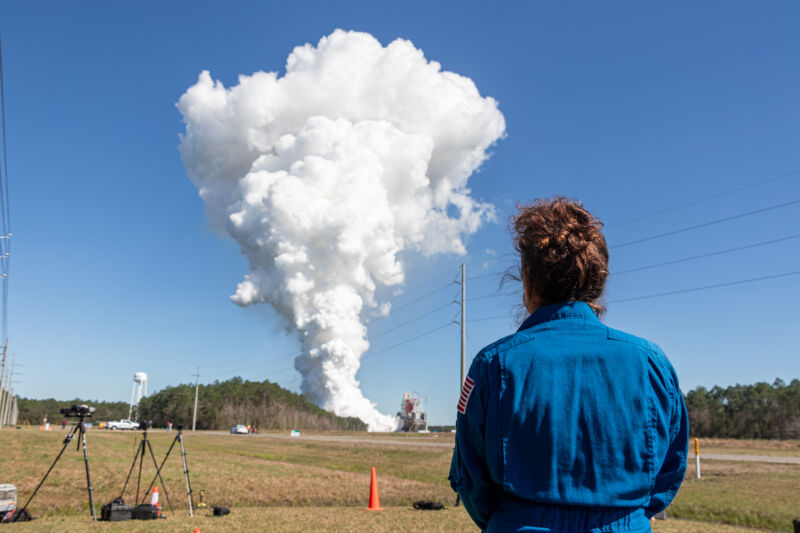Let’s do launch —
“The RS-25 is a great program for us.”
Eric Berger
–

Enlarge / NASA astronaut Jessica Meir looks on as the SLS core stage completes a full-duration eight-minute firing.
Welcome to Edition 3.37 of the Rocket Report! This week saw NASA reach a big milestone in igniting the four main engines of its Space Launch System rocket and firing them for a full duration of more than eight minutes. Whatever you think about the program, it’s worth taking a moment to celebrate this achievement with the engineers who pulled it off.
As always, we welcome reader submissions, and if you don’t want to miss an issue, please subscribe using the box below (the form will not appear on AMP-enabled versions of the site). Each report will include information on small-, medium-, and heavy-lift rockets as well as a quick look ahead at the next three launches on the calendar.

Virgin Orbit may go public, too. The Wall Street Journal reports that Richard Branson has hired Credit Suisse Group AG and LionTree LLC to explore taking Virgin Orbit public through a special-purpose acquisition company, with a valuation of up to $3 billion. The company successfully reached orbit for the first time earlier this year.
Another space SPAC … “The targeted valuation would mark a significant jump from the $1 billion the rocket startup had been aiming for last year, from a previously planned private fundraising. The company still hasn’t ruled out a private fundraising but is now focused on a SPAC,” the newspaper reports. This would be an impressive valuation. (submitted by Ken the Bin)
German rocket company to use Ukrainian engines. Rocket Factory Augsburg announced last year that its first booster, RFA One, would have the capability of launching 1.2 tons to a polar orbit. This impressive increase in the rocket’s performance, from 200 kg in an earlier iteration, caught the eye of German space reporter Frank Wunderlich-Pfeiffer. He was skeptical because the launch price remained the same, about 3 million euros.
Playing catch-up … Eventually, Wunderlich-Pfeiffer found the answer. RFA had decided not to develop its own engine but to source it from Yuzhmash, the Ukrainian state-owned aerospace manufacturer. He reported this finding in the golem.de publication, and RFA confirmed it in a subsequent statement. The company cited as one reason for its decision that commercial competitors in the United States were “much further” ahead in developing their small satellite launch vehicles. (submitted by TM)
The easiest way to keep up with Eric Berger’s space reporting is to sign up for his newsletter, we’ll collect his stories in your inbox.
FAA renews Pegasus rocket-launch license. After completing a comprehensive review, the FAA said this week it has approved the renewal of two Launch Operator Licenses for Orbital Sciences, a subsidiary of Northrop Grumman. The licenses are valid for five years and authorize the company to conduct flights of its Pegasus launch vehicle from Wallops Flight Facility in Virginia and Cape Canaveral Space Force Station in Florida.
How many more missions? … Northrop must still receive FAA authorization for specific launches. Pegasus was the first successful, privately developed orbital rocket. Its future, however, is uncertain. The booster has been surpassed by smaller vehicles that cost a fraction of its launch price. It is also not clear what other missions are on the rocket’s manifest beyond the TacRL-2 launch later this year. (submitted by Ken the Bin)
SpaceX apparently bid Starship for a cubesat mission. A NASA competition to launch a cluster of six cubesats attracted a bid from SpaceX, which appeared to offer a vehicle other than its current Falcon 9 or Falcon Heavy, SpaceNews reported. NASA on March 11 released the source selection statement from the competition to launch the TROPICS mission, which was won by Astra.
No launch license yet … One of the five bids came from SpaceX, and in its assessment of the bidders, NASA noted a weakness in SpaceX’s proposal because the company “did not clearly demonstrate progress toward the resolution of the environmental assessment which results in risk associated with obtaining an FAA launch license, increasing the likelihood of delays that would affect contract performance.” This would appear to apply to Starship, rather than the Falcon 9 or Falcon Heavy. Separately, NASA also eliminated Virgin Orbit from the competition because its original bid did not fall in the “competitive range” the agency established. (submitted by platykurtic and Ken the Bin)
Relativity Space lands first Department of Defense contract. This week, the company announced it has won its first orbital launch contract from the US Department of Defense. This contract was awarded as a Space and Missile Systems Center Launch Enterprise as part of an effort to identify commercial solutions for low-cost, responsive access to space “as a service.” Relativity is seeking to launch its first rocket later this year.
Lots of contracts for an unflown rocket … For this military mission, the company is targeting a 2023 launch date on its Terran 1 rocket. According to the company, this agreement represents the ninth announced launch customer for Relativity and the third announced government customer, following the recently announced Venture Class Launch Services Demonstration 2 contract with NASA. (submitted by Ken the Bin and platykurtic)
India targeting seven more launches this year. The Indian space agency, ISRO, is targeting at least seven more launches in 2021, including an uncrewed Gaganyaan demonstrator mission to test technologies for an eventual human spaceflight. The missions will be launched on three different Indian rockets, Times of India reports.
Double the effort … The chief of ISRO, K. Sivan, said he considered this to actually be 14 different missions, involving the development of seven different satellites and launching on seven rockets. “We are confident of achieving this target and (our) top priority is Gaganyaan,” he said. (submitted by Ken the Bin)

Japan’s H3 rocket completes pressure test. This week, the Japanese Aerospace Exploration Agency completed a wet dress rehearsal of its new H3 rocket, developed by Mitsubishi Heavy Industries. The agency, JAXA, said the test at Tanegashima Space Center was a success. A launch attempt remains at least several months away.
Next stop, the Moon? … Japan’s answer to SpaceX’s Falcon 9 rocket, the H3, is not reusable. But with a launch price of around $50 million, it could be commercially competitive for some missions, and it will certainly be more competitive than the existing H2A rocket. There is also a pathway toward upgrading the H3 booster for lunar cargo missions.
SpaceX on the cusp of historic reuse milestone. SpaceX launched another batch of Starlink satellites early on Sunday morning and, in doing so, came close to a substantial rocket-reuse milestone. The first stage of the Falcon 9 rocket that lofted this payload toward orbit, Booster no. 1051, was making its ninth flight. It successfully landed on the Of Course I Still Love You droneship.
Baseline goal of Falcon 9 upgrade … As this is the first Falcon 9 rocket to launch nine missions, it raises the prospect of a first stage making a 10th flight in the near future, probably within a month or two. Reaching 10 flights would accomplish one of the main goals set by SpaceX with the Falcon 9 rocket, after optimizing the vehicle for reuse about three years ago, Ars reports.
China to construct commercial spaceport. China will establish a commercial spaceport in the coming years to support the rapid growth of private space activities in the country, SpaceNews reports. The commercial space launch center was included in a list of national projects in the recently formulated Five-Year Plan that covers 2021-2025. China currently has four national launch centers that mainly support launches of Long March rockets from China Aerospace Science and Technology Corp., the state’s main space contractor.
No deets yet … Dou Xiaoyu—a deputy to the National People’s Congress, the top Chinese legislative body, and a vice chairperson at China Aerospace Science and Industry Corp.—called for a Chinese commercial spaceport project in order to meet an expected surge in demand for space launch services. No other details, including a potential location, were released. (submitted by Ken the Bin and platykurtic)
Amateur radio hackers decode SpaceX telemetry. Amateur radio enthusiasts in Europe managed to decode some portions of the telemetry data broadcast by the second stage of a Falcon 9 rocket when it was in orbit. YouTuber Scott Manley has an excellent video with all of the details.
Where cameras have not gone before … It is somewhat surprising that this data was not more rigorously encrypted, but its public release provides some pretty cool insights. Most notably, the engineering camera view inside the upper stage’s liquid oxygen tank was wild to see. (submitted by Wanderlost)

NASA successfully test-fires its SLS rocket. The road has been long, difficult, and expensive for NASA and its Space Launch System rocket. But on Thursday afternoon, the space agency got a taste of success with what appeared to be a nominal ground test-firing of the vehicle’s core stage. The main engines burned for 499.6 seconds, exhausting the vehicle’s supply of liquid oxygen, Ars reports.
Burn, baby, burn … After the test completed, engineers in the control room began clapping and cheering. Although days of data review lie ahead, the fact that the vehicle made it through a complete eight-minute test without stopping and in apparent good condition represents a huge win for NASA, the Space Launch System program, and the core-stage primary contractor, Boeing. In the coming weeks, NASA is also expected to set a target launch date for this Artemis 1 mission to fly an uncrewed Orion around the Moon and back.
NASA studying ways to reduce cost of the SLS rocket. After a report in Ars Technica, NASA confirmed it is studying ways “to find efficiencies and opportunities to reduce costs” in the Space Launch System program. The analysis is being led by Paul McConnaughey, a former deputy center director of NASA’s Marshall Space Flight Center in Huntsville, as well as its chief engineer.
Concerns about costs … With a maximum cadence of one launch per year, the SLS rocket is expected to cost more than $2 billion per flight, and that is on top of the $20 billion NASA has already spent developing the vehicle and its ground systems. Some Biden administration officials do not believe the Artemis Moon Program is sustainable with such launch costs.
Aerojet says revenue from shuttle main engines is increasing. Speaking at the J.P. Morgan Industrials Conference March 15, Dan Boehle, chief financial officer of Aerojet Rocketdyne, said the engines used on the Space Launch System rocket are an increasing source of revenue for the company. The RS-25 accounts for an increasing share of Aerojet’s revenue, going from 14 percent to 18 percent of overall revenues in the last few years, SpaceNews reports.
Netting a tidy profit … Boehle said that program should stay at that level over the next few years, growing at the same pace as overall company revenues. “The RS-25 is a great program for us,” he said. It seems noteworthy that the 50-year-old space shuttle main engine is a growing profit center for Aerojet Rocketdyne, especially when eliminating its reuse capability should be driving costs down, not up. (submitted by Ken the Bin)
Next three launches
March 20: Soyuz 2.1a | Ride-share mission including Astroscale ELSA-d mission | Baikonur Cosmodrome, Kazahkstan | 06:07
March 22: Falcon 9 | Starlink-22 | Cape Canaveral, Florida | 22:19 UTC
March 25: Soyuz | OneWeb-5 | Vostochny Cosmodrome, Russia | 02:47UTC


